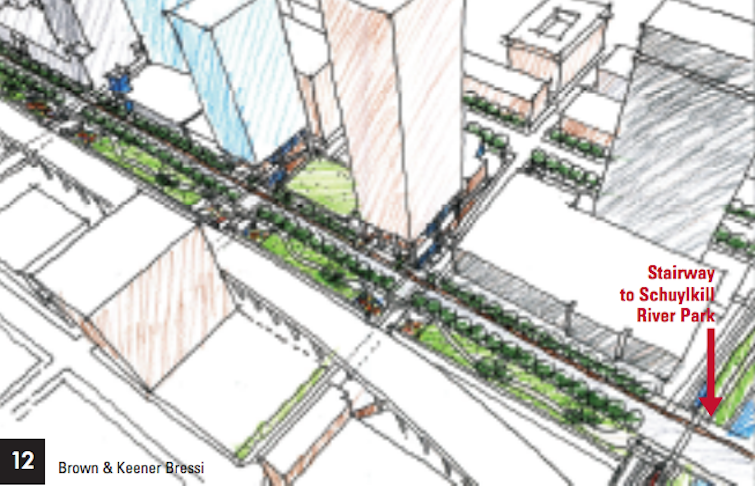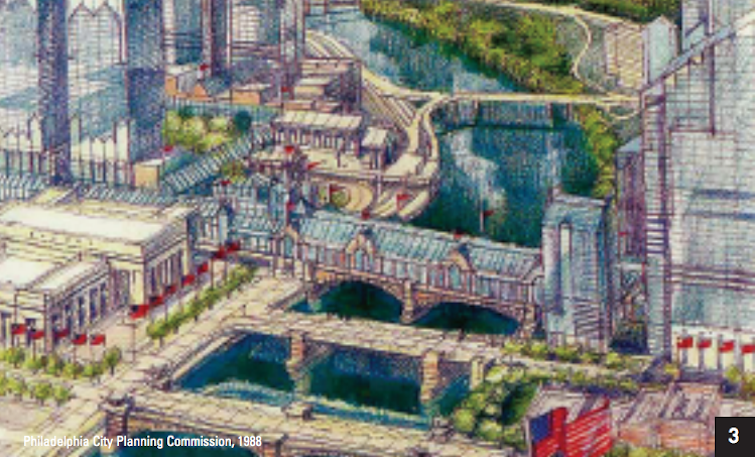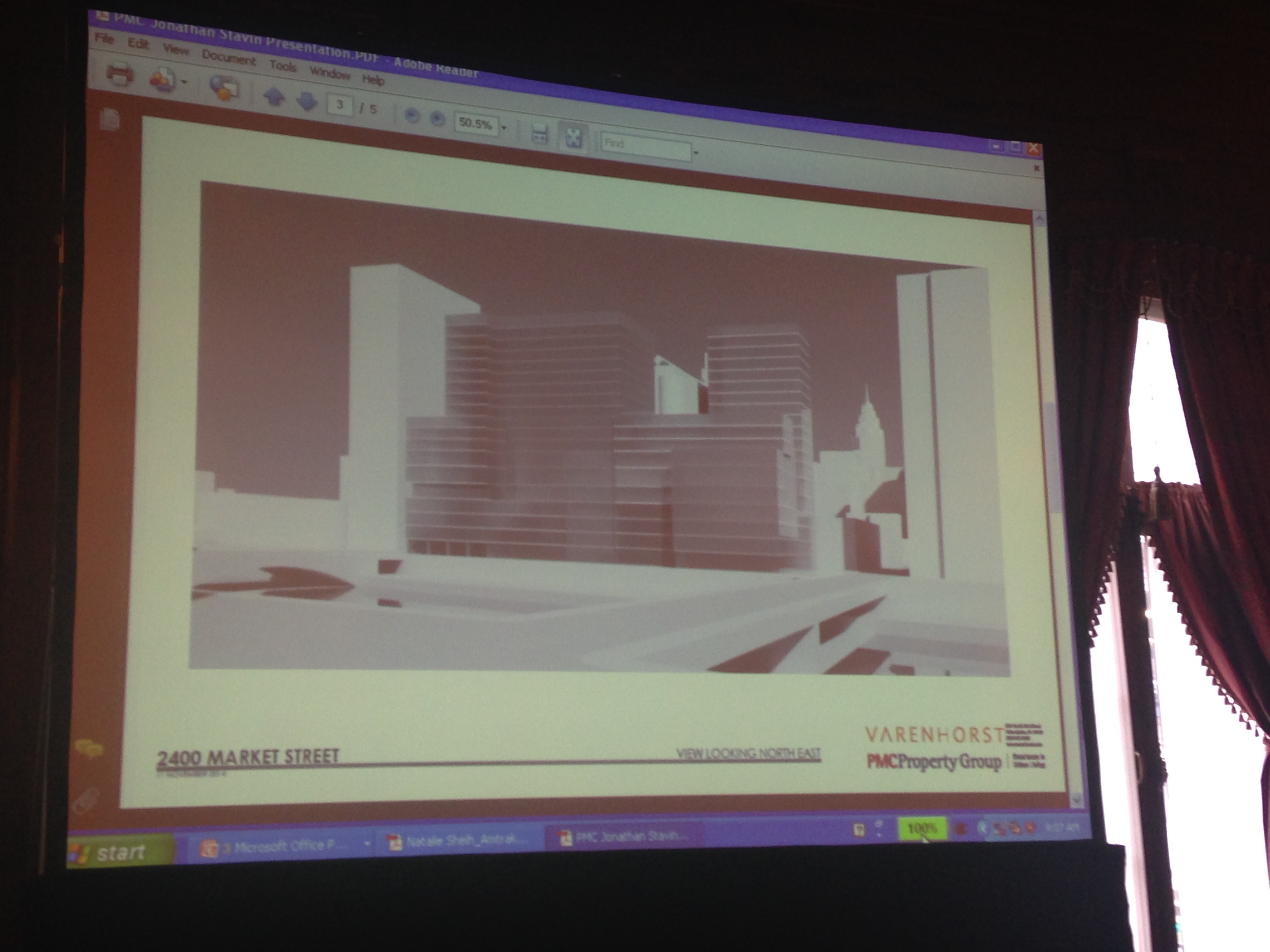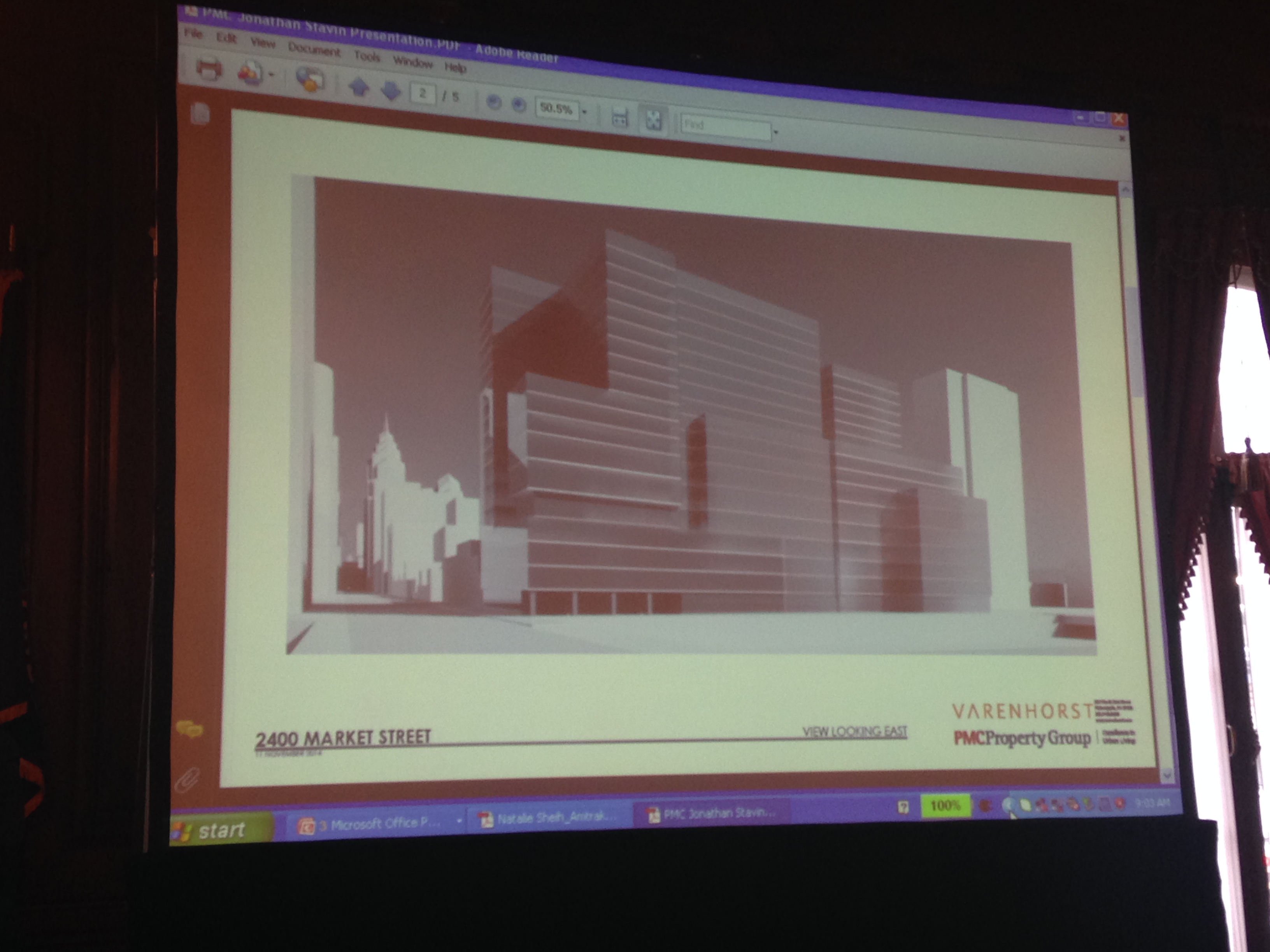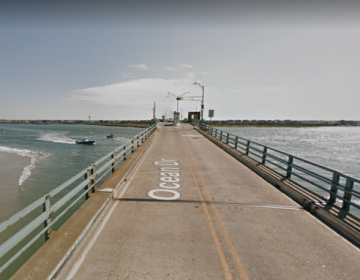Center City District’s dream of a street-level pedestrian promenade on the Schuylkill could become reality
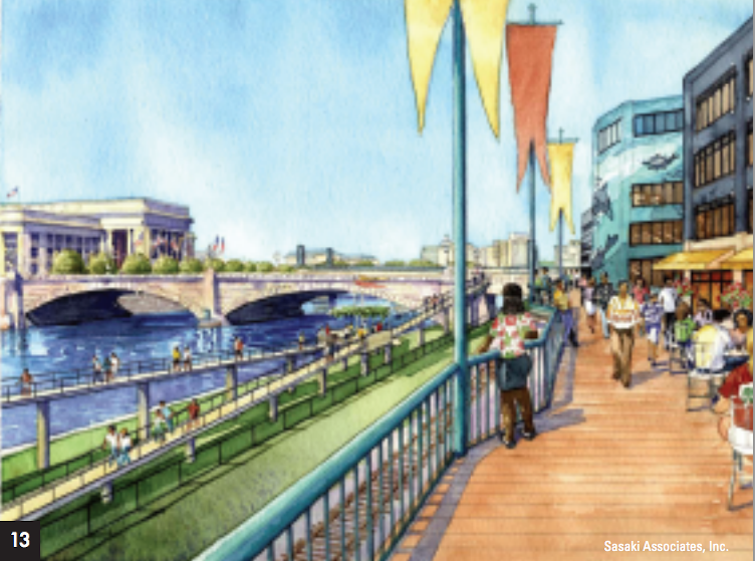
Center City and University City are Philadelphia’s two largest employment hubs, hosting 42% and 11.5% of the city’s jobs, respectively, and the business communities on both sides of the river increasingly see value in knitting the two places together by reconceptualizing the Schuylkill River as a connector, not a boundary.
It’s a huge challenge. The idea has attracted interest for a few decades now, but declining population numbers, a stagnant economy, and the challenging legacy of mid-20th century planning on the built environment – waterfront highways and pedestrian-hostile superblock development right at the University City gateway – had until recently conspired against the big investments required for greater connectivity.
Center City District’s 2007 report Center City: Planning for Growth summarized the challenges:
Throughout the 1990s, the area west of 21st was dominated by surface parking, deteriorated properties, vacant lots and marginal uses. The marquee of an “adult” theater remained a primary landmark. Physical barriers and changes in elevation, vestiges of the old Chinese Wall, elevated JFK Boulevard and a lack of street-level activities rendered the area unwelcoming for pedestrians and disconnected from adjacent residential areas and from University City. Today, the area remains an inappropriate gateway to Center City from 30th Street Station.
That hasn’t stopped CCD from dreaming big, though. Here are a few of the ideas that the report proposed:
- Realigning the southbound off-ramp from the Schuylkill Expressway at 30th Street so it connects with a two-way 29th Street, to allow a direct left onto JFK Boulevard and Market Street.
-
Making West Market Street and JFK Boulevard two-way streets from the Schuylkill River all the way to City Hall
-
Creating new distinctive headhouses, a new “mark” for transit, improved signs and real-time information to increase ridership of the trolley lines connecting Center City and University City.
-
Improving regional transit access to West Market Street through either a new 22nd Street Market-Frankford subway stop, and extension of PATCO from 16th and Locust Street to 22nd and Market and 30th Street Station, or a new light-rail line to connect all of Center City along Market Street to the Delaware River.
- Building a linear green park from 20th and JFK with connections to Schuylkill River Park.
-
Improving pedestrian and bicycle facilities on the bridges spanning the Schuylkill River.
- Creating an upper-level pedestrian promenade along the east bank of the Schuylkill.
Seven years later, none of these things have happened, aside from some basic bike lane striping on the Walnut St. and Chestnut St. bridges.
But CCD CEO Paul Levy believes that the moment is finally right to revive some of these big ideas, as they “connect with tremendous interest by developers, by institutions, by transportation agencies all working around the same theme” – essentially, the creation of a “unified business, research, education, retail, residential center” spanning from roughly Front St. to 50th St. that is “completely transit-oriented.”
“The interesting thing about ideas,” he said, introducing this morning’s CCD panel on linking Center City and University City, “is that they can sit out there until the market reality, until developer reality, until the momentum move to give life to them.”
While acknowledging the success and contributions of groups like the Schuylkill River Development Corporation in improving conditions down on the river level, Levy made the case for turning an eye toward “the bridge and city level” and focusing on bike and particularly pedestrian improvements.
Levy specifically mentioned the upper level pedestrian promenades as an idea he’d like to pull off the shelf again, but neither he nor the rest of the panel dwelled too much on the minutiae of streetscape improvements or right-of-way changes.
Rather, it was an opportunity for representatives from Brandywine, PMC Properties, Drexel, and Amtrak to update planning and development professionals on several projects, at various stages of planning and implementation, that will set the stage for more pedestrian activity near the riverfront, and help make the case for changes in the vein of CCD’s 2007 report recommendations.
Jeff DeVuono, Executive Vice President and Senior Managing Director of Brandywine Realty Trust took a look back at the recent history of the big high-impact investments on the western riverfront, starting with the Cira Center in 2005, the renovation of the old Post Office building for the IRS, the Penn playing fields, the Porch at 30th St Station, 3020 Market St, Brandywine’s first residential project with Evo at Cira Center South and the FMC tower, the various Drexel efforts to turn the area behind 30th St. station into the gateway to Drexel’s campus, and Amtrak’s ongoing planning process for the area around 30th St. Station.
DeVuono briefed the audience on the details of the FMC Tower at Cira Center South in University City, which you can read about over at Curbed, with special attention to the Cira Green park space, and relayed Brandywine’s hope that the cumulative impact of theirs’ and others’ investments will bring about a “24-hour situation” livening up what is currently an institutional dead zone at night.
“I think one of the challenges for University City was always those big massive buildings and those big blocks,” he said, “It feels like it’s a long runway, but it’s really not. It’s no different than Center City proper, but it’s just not broken up into individual properties with different amenity bases around it, so Brandywine and the team has spent a lot of time trying to focus on street engagement. The mission is to help build a community.”
Jonathan Stavin, the Executive Vice President for PMC Property Group, also gave a presentation on PMC’s plans for the Marketplace Design Center property at 2400 Market St.
PMC is planning a million square foot development for the site (yes, the whale mural is going away), about equivalent in space to 2 Liberty Place.
Likening the west Market St. corridor, and 2400 Market in particular, to a “hole in the donut” of a revitalizing Center City and University City, Stavin announced PMC’s plans for 300 apartments, a 150-key hotel, 200,000 square feet of office space, 120,000 square feet of design center (already there, but being relocated and compressed onto two floors), an unspecified number of parking spaces, and first floor retail promenade akin to what Paul Levy and CCD proposed back in 2007.
“The challenge at 2400 Market is it’s such a tight site – how do you get people around the building and bring them in? And the way to do that is going to be to connect Market and Chestnut St on the Schuylkill River with an outdoor promenade, without going over the CSX railroad tracks.”
Stavin explained that the railroad presents a challenge for the immediate area right behind Schuylkill River Park, so PMC thinks the right place for retail is up at the street level. They feel there are enough connections to get people down to the river, but “crossing between Market and Chestnut continues to be a challenge.”
Gensler is in charge of conceptualizing the building. Currently they’re envisioning Market St. as the entrance for the office tenants. The office floors will start on the 4th floor of the existing building – a 60,000 square foot footprint – and will house “a new tenant to the Philadelphia marketplace with an exciting concept already working in New York, Chicago, and Los Angeles.”
Then they’ll construct a 5th and 6th floor of office space targeting a slightly lower price point to market to newer businesses. Floors seven through nineteen will house the 300 apartments.
“Many of you know 2040 Market … the success of that location, and now the continued success at 1900 Arch St. has convinced us that people want to live closer to the river,” Stavin said.
“Seventy percent one bedrooms, 20% two bedrooms, and 10% three bedroom apartments. We have absolutely seen demand in our new product for larger apartments, apartments for families – and by families I don’t mean just small children, but extended families, young people that have parents coming to live with them. So there’s a need for a larger apartment, and there’s also a need for proximity to other amenities right within the building for older residents. This isn’t going to be senior housing in any way, but it’s certainly going to be a property where people can go there and everything they need will be within the building.”
Stavin held out the possibility of building the project in stages, with the offices and apartments coming first, and the hotel coming later, but he speculated that it may be more likely for the hotel to be built in conjuction with the other elements.
PlanPhilly snapped some pictures of the preliminary renderings, which really just capture the massing at this point:
WHYY is your source for fact-based, in-depth journalism and information. As a nonprofit organization, we rely on financial support from readers like you. Please give today.



